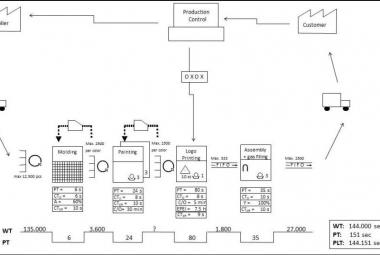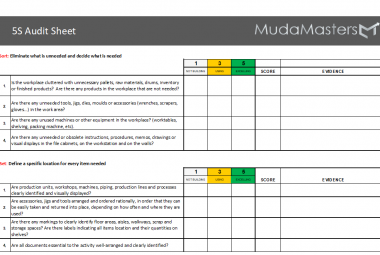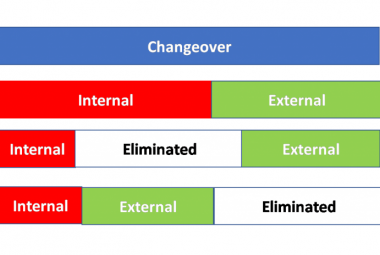Previously, we have discussed 5S in general, the phases Sort and Straighen, and the phases Sweep and Standardizing in previous articles. This article will discuss the final phase of 5S the sustain phase. All these articles are coverd in the book Sustainable 5S.
The fifth and final S in the 5S model stands for SUSTAIN, and this is the most difficult of the stages to implement in practice. It is difficult because this stage circles back on all the prior stages to ensure that they are being appropriately maintained and updated as necessary. The sustain stage therefore has two main objectives: sustaining the current standard as they were agreed upon by the team and identifying improvements when the standards are no longer relevant or complete.
An aid that can be used to check whether the standards are sustained is a mini-audit. By writing short questions on a T-card (a small card in the shape of a T so that it can easily fit a plan board) everyone can perform a mini audit in an area of their choosing. The cards can include questions such as; “Are all materials placed at their specified location?”, “is there something missing that you need to do your job properly or better?”, “are the tools on the shadow board cleaned according to standard?”
The easiest way to perform such an audit, is by linking each T-card to the standards defined in the previous step, leading to one T-card per standard.
Figure 4 shows an example of a T-card system that is used in a Dutch factory. On the left, a board with different T-cards is shown on which the mini-audit cards are kept and can be accessed on the shop floor.
The right picture shows an example of one T-card in the hand of an operator, on which the use of a team board is assessed.
Figure 4: example of a T-card system and a T-card mini audit
If there is a need for a more thorough 5S audit, it is possible to create a longer list of questions using A4 paper. Such a longer list can include different categories of questions.
Firstly, the questions could be listed by groups according to the areas within a department. These corners would represent the locations at a workstation that need to be checked one by one. In this case, instead of 4 pictures on one paper, you would have 4 parts of the audit with questions related to each part specifically.
Secondly, the larger audit form could include questions specifically designed to indicate the level of sophistication on each of the 5 stages of 5S. Doing so would make it possible to assess the 5S maturity of a team, based on their progress on each of the 5 stages. Questions in this kind of audit could include: questions about the red tag zone and its use in the first stage, the use of shadow boards and the lines on the floor in the second stage, or cleaning according to the cleaning schedule in the third stage, etc.
Third, the expanded audit form can contain questions that are designed to measure the overall level of understanding of 5S in the team. Questions such as “what does 5S mean?”, “why do we want to implement 5S” and “what advantages does the 5S standard bring you as a team working in this area?” re all useful measures of the extend of comprehension.
Figure 5: two examples of a 5S-auditform
Figure 5 above shows two examples of 5S audit forms. The example on the left depicts an example that I found in Germany which shows the extended format that contains questions for each stage of 5S. The example on the right is a more abbreviated example and depicts a combination of pictures and area-specific questions. I found it in use in a factory in Turkey. More examples of 5S audits can be found here.
The advantage of having a structured question list is that the answers to the questions can be scored and the overall scores can be tabulated. The overall score of the 5S audit can serve as an indicator of the level of maturity of the area and the personnel being audited. You can share these results with the team(s) involved and use it to lay out the next set of action steps that need to be taken to improve the score.
To provide an idea regarding how far it is possible to progress in promoting a 5S initiative, I will share one of the most elaborate 5S board I have seen thus far in my career. It is shown in figure 6.
Figure 6: an example of a 5S-bord
This board includes the following:
- An introduction to 5S,
- Before and after pictures of the last improvements of the 5S standards,
- An overview of who is doing the 5S mini-audits, when they are planned, and when they are done,
- A list of open 5S actions to improve the standard,
- The latest 5S score
- A trendline chart composed of the audit scores over the course of a year for each of the three corners in this area,
- A KPI record of how many 5S improvements have been implemented on a weekly basis over the course of a year.
When I am doing a 5S audit, and there are no specific cards or forms with questions, I simply use the picture that is displayed as the standard on the shop floor. I compare it with what I see around me. When I see a discrepancy, I can ask a team member what is going on by simply pointing to the standard and asking why the current state no longer resembles the standard that has been agreed to and published.
Based on my experience, I consider the red tag zone (for sorting) and the 5S mini audit (for sustaining) to be the most important tools in the 5S Practice toolbox. They both play a critical role in keeping the 5S model alive and functioning as a key part of daily operations. They help prevent the believe or notion that practicing 5S is just a one-time or a once-in-a-while thing.
For example, when it comes to the red tag zone tool, items that do not belong at a workstation can constantly be tagged and moved to the red tag zone for further action. Anyone is then free to remove it and bring it back to a workstation where it either belongs or is needed. Or—if it turns out that item did have a function in its original area—a fixed location can be created at the workstation and the 5S standard updated.
Continue to:
Sustainable 5S - T.Panneman (summary)
REFERENCE:
Panneman, T., 2019, Sustainable 5S - How to Use the lean Starting Tool Tool to Improve Flow, Productivity and Employee Satisfaction, Dublin: MudaMasters (summary / order this book)











